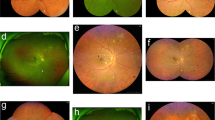Abstract
Background
The aim of this study was to compare how diabetic retinopathy was detected from red-free digital images and colour transparencies.
Methods
Two ophthalmologists graded two-field, nonstereoscopic, 60° red-free digital images and colour transparencies utilizing an ETDRS-based grading scale, from 107 mainly type 2 diabetic patients. The discordantly scored eyes were graded by the graders together to obtain a consensus level of retinopathy for each method. The eyes with discordant consensus grading results were further graded using all available photographic material to reach a final consensus level of diabetic retinopathy. Intermethod variations were presented as percentages and using kappa (k) and weighted kappa (wk) statistics. The errors of the two consensus gradings with respect to the final consensus grading were compared using McNemar’s test.
Results
For the colour transparencies there was an agreement between the individual and the consensus grading results in 93% (k=0.90, wk=0.97) and 86% (k=0.79, wk 0.88) for grader 1 and grader 2. Corresponding figures for red-free digital images were 88% (k=0.83, wk=0.96) and 84% (k=0.78, wk 0.91). Agreement between methods was obtained in 76/107 eyes (71%; k=0.58 and wk=0.79). In the 31 discordantly graded eyes the level of retinopathy was underestimated in 20/31 (64%) vs 7/31 eyes (23%) and overestimated in 1/31 (3%) vs 3/31 eyes (10%) from colour transparencies and red-free digital images, respectively. The error tendencies were significantly lower when using red-free digital images (p<0.008).
Conclusions
Red-free digital images are comparable with two-field colour transparencies in the identification of mild to moderate nonproliferative diabetic retinopathy.

Similar content being viewed by others
References
Agresti A (1990) Measuring agreement. In: Agresti A (ed) Categorical data analysis. Wiley, New York, pp 365–370
Early Treatment Diabetic Retinopathy Study Research Group (1991) Fundus photographic risk factors for progression of diabetic retinopathy. ETDRS report number 12. Ophthalmology 98(5) [Suppl]:823–833
Fransen SR, Leonard-Martin TC, Feuer WJ, Hildebrand PL, The Inoveon Health Research Group (2002) Clinical evaluation of patients with diabetic retinopathy. Ophthalmology 109:595–601
George LD, Halliwell M, Hill R, Aldington SJ, Lusty J, Dunstan F, Owens DR (1998) A comparison of digital retinal images and 35 mm colour transparencies in detecting and grading diabetic retinopathy. Diabet Med 15:250–253
Hellstedt T, Vesti E, Immonen I (1996) Identification of individual microaneurysms: a comparison between fluorescein angiograms and red-free and colour photographs. Graefes Arch Clin Exp Ophthalmol 234:13–17
Henricsson M, Karlsson C, Ekholm L, Kaikkonen P, Sellman A, Steffert E, Tyrberg M (2000) Colour slides or digital photography in diabetes screening—a comparison. Acta Ophthalmol Scand 78:164–168
Klein R, Klein BEK (2002) Screening for diabetic retinopathy, revisited. Am J Ophthalmol 135:261–263
Landis JR, Koch GC (1977) The measurements of observer agreement for categorical data. Biometrics 33:159–174
Liebetrau AM (1983) Measurements of association. In: Sage university paper series on quantitative applications in the social sciences, series no. 07- 032, 1st edn. Sage, Beverly Hills
Liesenfeld B, Kohner E, Piehlmeier W, Kluthe S, Aldington S, Porta M, Bek T, Obermeier M, Mayer H, Mann G, Holle R, Hepp K-D (2000) A telemedical approach to the screening of diabetic retinopathy: digital fundus photography. Diabetes Care 23:345–348
Lin DY, Blumenkranz MS, Brothers RJ, Brothers RJ, Grosvenor DM (2002) The sensitivity and specificity of single-field nonmydriatic monochromatic digital fundus photography with remote image interpretation for diabetic retinopathy screening: a comparison with ophthalmoscopy and standardized mydriatic colour photography. Am J Ophthalmol 134:204–213
Olson JA, Strachan FM, Hipwell JH, Goatman KA, McHardy KC, Forrester JV, Sharp PF (2003) A comparative evaluation of digital imaging, retinal photography and optometrist examination in screening for diabetic retinopathy. Diabet Med 20:528–534
Tennant MTS, Greve MDJ, Rudnisky CJ, Hillson TR, Hinz BJ (2001) Identification of diabetic retinopathy by stereoscopic digital imaging via teleophthalmology: a comparison to slide film. Can J Ophthalmol 36:187–196
von Wendt GC, Heikkilä K, Summanen PA (1999) Assessment of diabetic retinopathy using two-field 60° fundus photography. A comparison between red-free, black-and-white prints and colour transparencies. Acta Ophthalmol Scand 77:638–648
von Wendt GC, Rönnholm P, Heikkilä K, Summanen PA (2000) A comparison between one- and two-field fundus photography when screening for diabetic retinopathy. Acta Ophthalmol Scand 77:14–20
von Wendt GC, Heikkilä K, Summanen PA (2002) Detection of retinal neovascularizations using 45° and 60° photographic fields with varying 45° fields simulated on a 60° photograph. Acta Ophthalmol Scand 80:372–378
Acknowledgements
This work was supported by grants from the Eye Foundation, Finland and Helsinki University Central Hospital Research Fund (TYH 3263), Finland, and the foundation Stiftelsen Synfrämjandets Forskningsfond, Sweden.
Author information
Authors and Affiliations
Corresponding author
Rights and permissions
About this article
Cite this article
von Wendt, G., Summanen, P., Hallnäs, K. et al. Detection of diabetic retinopathy: a comparison between red-free digital images and colour transparencies. Graefe's Arch Clin Exp Ophthalmol 243, 427–432 (2005). https://doi.org/10.1007/s00417-004-1068-7
Received:
Revised:
Accepted:
Published:
Issue Date:
DOI: https://doi.org/10.1007/s00417-004-1068-7




